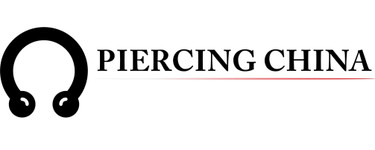History of Piercings
What is a piercing?
Speaking in precise terms, a piercing is simply the perforation of one part of the human body through which then a piece of jewelry is inserted. This means that any artificially and intentionally created hole through a human body is considered a piercing. As for the piece of jewelry which is inserted through the hole, it can have different functions from being simply there to avoid the closure of the perforation to decorative or spiritual reasons. In some cases, the desired effect can even be to increase or decrease the functionality of the pierced body part such as in the case with some genital piercings. So, when we talk about piercings throughout human history, it's best to look at the history of piercings for each body part separately.
History Of Lip Piercings Or Labret Piercing History
This is certainly one of the oldest piercing types and it's impossible to say at this time when humans started to pierce their lips. For example, the indigenous tribes in Africa such as the Mursi tribe from the Omo Valley which is a remote region of Ethiopia have the custom that: young women upon reaching puberty will start to wear labret plugs of ever-increasing sizes as an expression of their beauty and also as an identification with their own tribal history. 1
Also in Africa but in Tanzania, remains of a human skeleton have been found which could be dated to roughly 12,000 BC. This skeleton of a young male showed abrasion on his teeth which matches the damages caused by lip piercings and cheek piercings. 2
Lip plate piercings are also found in some of the tribes of the Amazonia in South America such as the Kayapo tribe of which the Brazilian activist and chief Raoni Metuktire is one of the most well-known public figures. In this ethnic group, the older men wear disk labret as a sign of social status which stems from their age. 3
Accordingly, we can assume that the custom of lip piercing and the wearing of labret jewelry are probably thousands of years old.
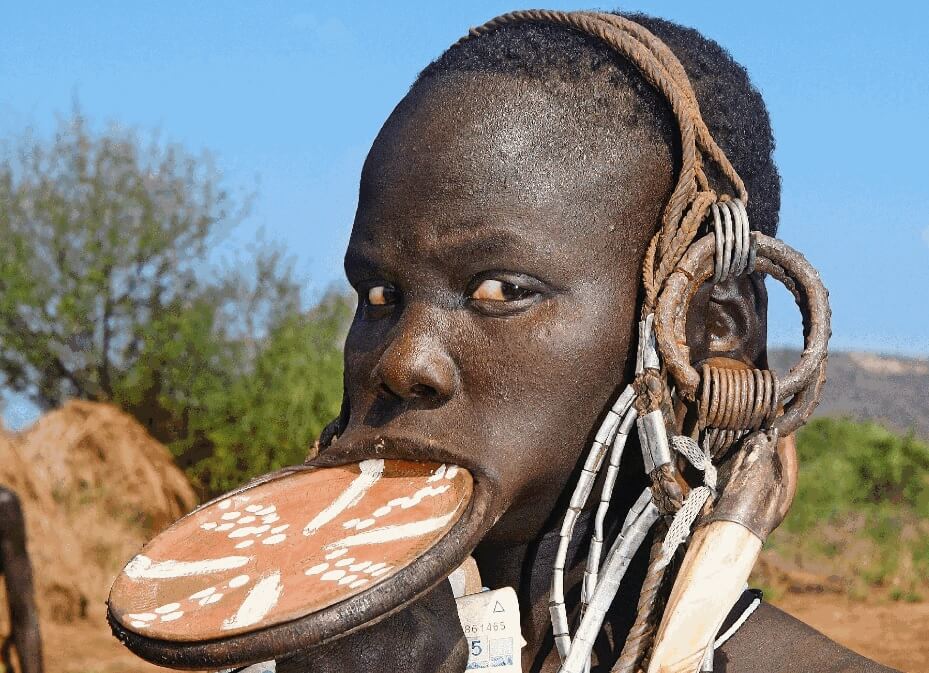
Mursi women with Lip Plate
History of nose piercings
Nose piercings and septum piercings are very common among many tribal communities over a very wide geographical area. Some of the best and most diverse examples are probably the following:
Large nose septum piercing jewelry made from bones by Aboriginal Australians where until very recently was common for men. Fossil records from the Kimberly region found a septum jewelry made out of bone from 55,000BC which currently is considered the oldest jewelry ever worn by a Homo sapiens. 4
When we talk about the history of nose jewelry, many people will think about India. In the Indian subcontinent, nose jewelry was an established cultural norm across the entire Indian subcontinent since at least the birth of Buddha since some of the statues and texts from that period makes references to nose jewelry.
In the bible, there are several references to nose rings. So, we can assume that in that cultural area, nose piercing was something common.
Ezekiel 16:12 “And I put a ring on your nose and earrings in your ears and a beautiful crown on your head.”
Genesis 24:47 ESV : Then I asked her, ‘Whose daughter are you?’ She said, ‘The daughter of Bethuel, Nahor's son, whom Milcah bore to him.’ So I put the ring on her nose and the bracelets on her arms.
Isaiah 3:18-23 In that day the Lord will take away … nose rings; the festal robes, , and the handbags; ...
In the Berber culture of northern Africa, nose rings are given by men to their future wives as a gift and to offer them financial security in the case of premature dead of the husband. The value of the nose rings gifted serves also as an indicator of the wealth of men and his family. In addition to that, in Central Africa which is considered the cradle of humankind, nose piercings are also found in several forms throughout different tribes.
In south America, in the Amazonian basin, nose piercings most commonly in the form of septum jewelry made from wood, bone or horn are found in majority of the tribes including the uncontacted tribes which have until now never had direct contact with our modern civilized world. A good example for this is the tribe of the Matsés or Mayoruna which live in the Amazonian rainforest on the border between Peru and Brasil. In this culture, the women will insert thin wooden spikes into their nose in order to imitate the appearance of a jaguar giving the tribe their nickname “the jaguar people” 5

Australien Aboriginal nose piercing
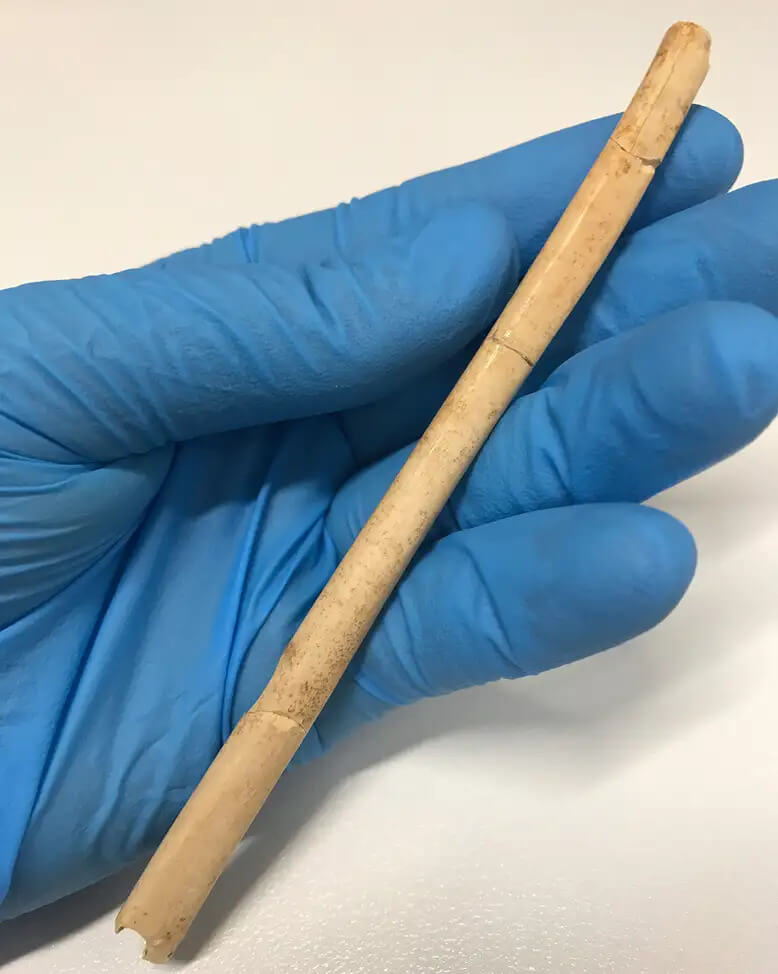
worlds oldest piercing from 55.000 BC
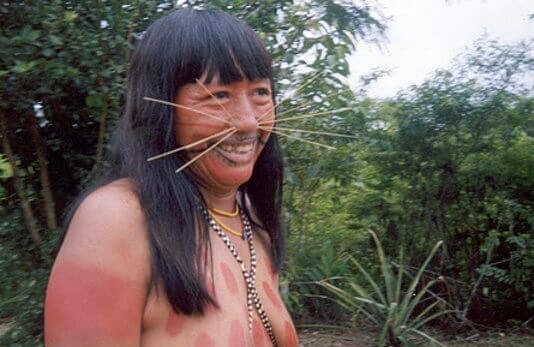
Matses women with nose piercing
History of ear piercing and ear stretching
Considering that the earlobe is one the thinnest part of the human body, it’s not a surprise that it is one of the most common places for body piercings. In general, we can differentiate between two varieties; thin ornaments which are passed through the body perforation and then have a decorative top part facing forward, and larger jewelry which stretches the hole and shape of the ear lobe so the entire ear and the piece of body jewellery become a form of body art. Ear piercing have been practiced in basically all cultures around the world since historical times. And also ear stretching was a very common practice for traditional tribes before they came in contact with modern civilization.
In the Solomon Island, it’s common for men in tribal communities to practice ear piercing as well as ear stretching. Due to how inaccessible and remote these islands were in the historical times, it can be assumed that this practice dates back several thousands of years.
In Indochina, there are several tribes living in the mountainous area of Laos, Thailand, Vietnam and Myanmar such as the Karen and Lahu tribe as well as some small lesser known tribes in northern Vietnam where ears are slowly stretched over time by inserting plugs made from natural materials or silver or by wearing heavy ear weights.
In India and Nepal, many old images and statues of Buddha feature elongated ears and it is believed by some scholars that this is due to the fact of wearing ear weights. Since Buddha started his life as a local prince, this is plausible since it was common practice at that time for people of high social status to wear ear weight made out of solid gold.6
In ancient Egypt, ear piercing and ear stretching were common by the second intermediate period which means around 1670 BC. And since several mommies from that period are well preserved, we actually have the ability to still see their body modfications. One of the most famous Egyptian pharaohs is without a doubt Tutankhamun who reigned from 1333 BC until 1323 BC. When his mommy was inspected, the forensic experts found that his ears had been stretched to the size of 10mm or 00g. Also, in burial chamber from this period, we can see these ancient plugs between other burial gifts. 7
In Africa, girls from the Fulani tribe will have the ear pierced roughly at the age of 3 and will wear very large ornate earing by the age of entering into puberty. And for people from the Masai tribe, ear stretching is fundamental part of their tribal heritage
In Europe, we have another very famous case of ear stretching during the early copper age at around 3260 BC. Of course we are talking about Ötzi, also called the Iceman. This is a frozen mommy which was found in 1991 in Austria and the end of a glacier. Due to the fact that his body had been conserved by freezing all soft tissues where perfectly preserved, when his remains where analyzed, it was found that he had his earlobes stretched to a size of about 6 – 7mm.
In more recent history around 1000 BC and until the arrival of the romans, the only tribe from which we have evidence of piercing are the Slavic tribes where evidences of ear rings have been found in several archeological excavation’s sites of that period.
In south America, in the Amazonian rainforest of Ecuador, we can find the Huaorani which practices ear stretching for women and men. They commonly use plugs made out of balsa wood as ear expanders. Another tribe which ear stretching is common is the Yanomami from Venezuela. Here after the piercing is stretched instead of wearing a solid plug, they wear a bunch of fur, leaves or flowers are inserted into the body perforation.

Egyptian Ear Plugs
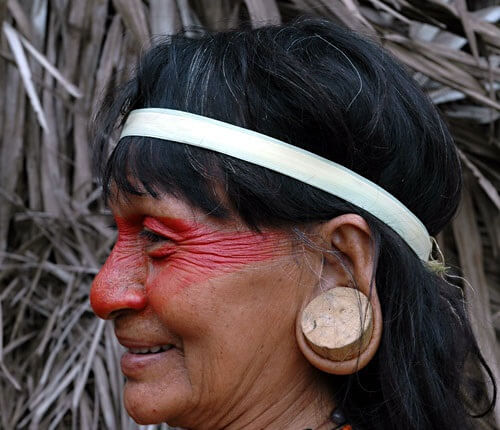
Huaorani with balsa plug

Yanomami with stretched ear

Lao Hilltribe with ear plugs
Conclusion,
From all the scientific evidences we have today, we can assume that body piercing as a form of body modification has been an integral part of human history across a wide geographical area and most likely has originated independently from each other several times. With this we can definitely answer that piercing is not something abnormal or strange or a new invention by younger generations. But instead, it is more of a rediscovery of an old art form by people who wanted to differentiate themselves from the main stream standard of beauty and appearance.
Origin of modern piercings and body jewelry
When we look at the modern history of body jewelry and piercing, there is actually a very precise time period where modern piercings are born. This precise moment is defined by the introduction of threaded surgical steel body piercing jewelry which for the first time in history allowed body jewelry to be inserted and fixed into a body perforation in areas where the previous method of using piercing jewelry rings such as ball closure rings is not a feasible option. A good example for these are tongue piercings.
The father of modern piercing is Horst Streckenbach from Germany. He initially worked as a tattoo artist but since 1953 started to perform genital piercings for which he used jewelry in ring shape such as ball closure rings. Due to his formal education in metal working, he constantly tried to improve the jewelry he was using. By 1971, he then finally developed the first straight threaded barbells. He shared this idea with Jim Ward from California whom he met in 1975. Jim Ward was himself a piercing pioneer and is today considered the father of Body Jewelry by many. Jim Ward and Horst Streckenbach continued to improve their designs and in 1978, the collaboration between the two artist resulted in Doug Malloy, a friend of Jim Ward, performing the first ever tongue piercing on Horst Streckenbach. After this, many different artists both in Europe and in the US continued to develop piercing jewelry finding ever new applications for body jewelry and at the same time adapting the jewelry to the needs of the different body perforations. By the late 1980, we then had all the different types of modern body piercing jewelry available in the market. But the production of it was still very small scale, so professionally made body jewelry was very expensive. And accordingly, professionally made body jewelry was only worn by people who belonged to some sup culture groups which had sufficient disposable income such as the gay and artistic community. In the punk community, piercings were also a staple, however, these would normally be improvised body jewelry such as the use a safety pin in ears or bend tiny ear rings used as nose jewelry. Then by the nineties, piercing factories in South Korea started to mass produce piercings and this resulted in a huge drop of prices which marked the beginning of wide spread use of industrially made threaded body jewelry at an affordable product for the mass market.

Horst Streckenbach also called Tattoo Samy.

Jim Ward
Piercings From China
By the year 1997 to 2003, we then could see body jewelry and piercing to really take off in terms of popularity and this resulted in many piercing related businesses being founded during that time. This was also when the mass production of body jewelry started to shift to China from South Korea. Chinese companies would produce body jewelleryjewelry in massive piercing factories. This led to a huge drop in the wholesale prices of piercing jewelry which allowed body jewelry wholesalers to enjoy huge profit margin which combined with the introduction of the Internet resulted in the rapid growth of many wholesale body jewelry websites. By 2010, however, retail prices of piercing jewelry started to drop since the market was over saturated. Also, during the time between 2000 and 2010, we could see that European and US companies seeing themselves unable to compete with Chinese piercing factories in terms of prices started to move into the premium segment of the body jewelry market. Currently there are no piercing factories left in Europe, United States or South Korea which produce piercing jewelry for the low to mid end of the market. This means any body jewellery which you can find for sale for less than 5 USD a piece for a basic steel initial piercing or 10 USD for a titanium product or more complex design in surgical steel most likely was produced in China. On a small site note, there are a few body jewelry production companies in Thailand which produce piercing jewelry of medium quality such as Salamander, Steel and Silver, KS Piercing but the rest of the companies from Thailand simply re-export body jewelry which they purchased at very low prices from Chinese piercing factories.
By the year 2015, piercing was not the latest trend everyone from the Generation Y or millennials had to follow but instead converted itself to an established niche market. Accordingly, we can see a greater variety in the body jewelry offered and also the customer became more knowledgeable and preferred to avoid the lowest quality body jewelry. During this time of consolidation, many well-known body jewelry websites such as 99 cent body jewelry which was famous for offering cheap body jewelry disappeared and the market consolidated around the players we see today.
During the times of the Covid-19, all those distributors which relied on merchandise produced from China were heavily affected by production delays and shortages of products were commonly seen in almost all piercing studios. Accordingly, we can say confidently that China is the Piercing Factory of the world and accordingly to our own estimates produces roughly 95% of all the body jewelry being sold in the market today. Also these day, piercing factories from China have diversified and offered a broad range of product quality, so the old saying that low quality body jewelry is from China, medium quality is from South Korea and high quality is from the USA or Europe is simply not true anymore. As of today, piercing factories in China which focus on producing high quality products have almost reached their US and European counterparts and we can expect that within the next 5 – 10 years they should have the same capabilities. However, we predict that they will focus more on the medium and low end of the market where they can best use their competitive strength which is to produce at scale and with a lower cost per unit.
Sources
1 https://uvhw.de/files/3_uvHW_Leseproben/uvHW-105-2_FULL-TEXT.pdf
2 https://www.newsweek.com/earliest-facial-piercing-africa-ancient-skeleton-1484600
3 Kayapó Ethnoecology and Culture ISBN9780415753784 https://books.google.co.th/books?id=TgOCAgAAQBAJ&printsec=frontcover&source=gbs_atb&redir_esc=y#v=onepage&q&f=false
4 https://www.newscientist.com/article/2113247-kangaroo-bone-nose-piercing-is-oldest-bone-jewellery-ever-found/
5 http://www.matses.info/
6 https://www.buddha-heads.com/buddha-head-statues/ears-of-the-buddha/
7 https://www.egypt.swan.ac.uk/the-collection-2/the-collection/earrings/
Author Klaus Ernst 2023
 Baht
Baht
 US Dollar
US Dollar
 Euro
Euro
 British Pound
British Pound
 Swiss Franc
Swiss Franc
 Canadian Dollar
Canadian Dollar
 Australian Dollar
Australian Dollar
 New Zealand Dollar
New Zealand Dollar
 Japanese Yen
Japanese Yen
 Argentine Peso
Argentine Peso
 Swedish Krona
Swedish Krona
 Danish Krone
Danish Krone
 Norwegian Krone
Norwegian Krone
 Polish Zloty
Polish Zloty
 South African Rand
South African Rand
